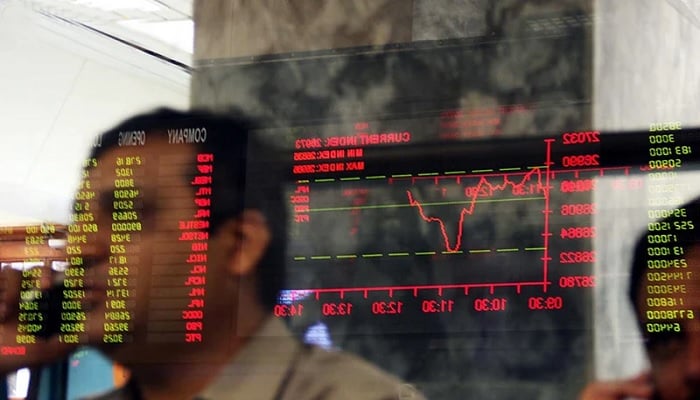PSX halts 4-day surge as IMF, Fitch reports spark economic fears
KSE-100 index closed at 117,226.14, down 1,204.21 points or 1.02% from the previous close of 118,430.35
April 23, 2025

- Index touched an intraday high of 118,811 and a low of 117,120.
- Economy-wary traders stayed cautious throughout the session.
- Topline report attributes reversal to regional geopolitical tensions.
Stocks on Wednesday retreated, snapping a four-day winning streak, as investor sentiment took a hit following economic projections by the International Monetary Fund (IMF) and Fitch Ratings.
The Pakistan Stock Exchange’s (PSX) benchmark KSE-100 index closed at 117,226.14, down 1,204.21 points or 1.02% from the previous close of 118,430.35. The index touched an intraday high of 118,811.24 and a low of 117,120.39.
Trading volumes stood at 242.5 million shares, with the total value of traded shares recorded at Rs18.6 billion.
Traders walked on eggshells throughout the session, alarmed about the country’s economic outlook as well as the possibility of further pressure on the currency.
Topline Securities, a brokerage, in a note said that after four consecutive sessions of bullish momentum, bears made a forceful comeback on the local bourse today.
“This reversal in sentiment can largely be attributed to escalating regional geopolitical tensions, which prompted investors to adopt a cautious stance and lock in recent gains,” the brokerage said.
The downward trajectory of the index was significantly influenced by negative contributions from key stocks, including United Bank Limited (UBL), Hub Power Company (HUBC), Habib Metro Bank (HMB), Mari Petroleum Company (MARI), and Engro Corporation Limited (ENGRO), which collectively dragged the index down by 526 points.
Despite the decline, investor participation remained robust, with total traded volume reaching 604 million shares and market turnover amounting to Rs27.7 billion. Bank of Punjab (BOP) led the volume chart, with 58 million shares changing hands.
In its latest World Economic Outlook, the IMF downgraded Pakistan’s growth forecast for the current fiscal year from 3% to 2.6%, citing slower-than-expected recovery.
Adding to the cautious mood, Fitch Ratings said Pakistan is likely to let the rupee weaken gradually to ease pressure on the current account as economic activity increases, according to Bloomberg.
IMF’s revised forecast follows fresh US tariff hikes of up to 29% by US President Donald Trump, which have led the IMF to cut growth estimates for several developing economies.
The report, however, noted that Pakistan's GDP growth for the next fiscal year (2025–26) is projected to rise to 3.6%.
Inflation in Pakistan, which stood at 23.4% in 2024, is forecast at 5.1% for the current fiscal year, with the IMF projecting it to rise further to 7.7% in the next fiscal year.
The IMF also revised its forecast for Pakistan’s current account deficit. It now expects the deficit to stand at 0.1% of GDP, compared to its earlier estimate of 1%. In nominal terms, the current account gap is expected to be just $400 million, instead of the previously projected $3.7 billion.
For 2026, the lender expects the current account deficit to further increase to 0.4% of the GDP.
Bloomberg, citing Krisjanis Krustins, Director of Asia Pacific Sovereign Ratings at Fitch, said: “The ratings company sees the rupee falling to 285 against the dollar by the end of June and weakening further to 295 by the end of the next fiscal year in 2026.”
A rupee drop to Rs285 per US dollar in two months would mean a 1.5% decline from the current interbank rate of Rs280.76. If it falls further to Rs295 by June 2026, that would be a 5% depreciation from today’s rate.
“Pakistan’s central bank will allow the rupee to gradually weaken to manage pressures on the current account as the economy gains pace,” the Bloomberg report added.











